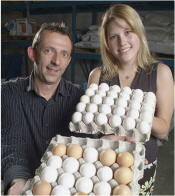



Researcher Delves Into Why Naturally Blind Chickens Perform Better
GUELPH - A strain of chickens that are naturally blind start reproduction earlier and produce more eggs per cycle than their sighted counterparts, a University of Guelph researcher is finding. Now he’s working to understand what influences the increased production in blind birds. |
| Animal science professor Gregoy Bedecarrats (left) and graduate student Jennifer Perttula |
Animal science professor Gregoy Bedecarrats has been studying how light affects reproduction patterns in a flock of blind Smokey Joes, a strain of White Leghorn birds. He says a better understanding of how light influences reproduction in birds will give producers more tools to alter light techniques for higher performance.
“We’re at the early stage, but this research will be very beneficial to producers as a management tool,” says Bedecarrats.
This study began in 2004, when Bedecarrats was given a flock of blind Smokey Joes by researchers from Michigan State University. At that point, few studies had been done with the blind birds, and he was eager to learn more.
Typically, chickens start reproductive development after sensing an increase in day length, Bedecarrats says. This happens when more light is absorbed by a portion of the brain called the hypothalamus, which secretes hormones and controls the part of the nervous system responsible for regulating automatic body functions such as temperature, blood pressure, thirst, hunger and the sleep-wake cycle. But in blind chickens, Bedecarrats learned light was being integrated differently.
In the study, he found that while light directly stimulates the hypothalamus, it also inhibits reproduction when it is perceived by the retina of the eye. Because blind birds lack the retina, they only experience the stimulatory influence on the hypothalamus, which encourages them to begin laying eggs earlier.
By studying the types of rays that comprise light, Bedecarrats says two different pathways co-exist in birds to interpret their daily exposure to light. The first is a pathway that involves blue-green light wavelengths (mainly perceived by the retina). The second pathway involves wavelengths from the red spectrum, which penetrate the skull and stimulate the hypothalamus.
With this knowledge, he suggests that blue-green rays can have inhibitory properties, and that red rays are what stimulate chickens to begin their laying cycle. When both pathways co-exist (in normally sighted birds), the length of the period of light they are exposed to each day dictates the physiological response. So, in short days the inhibitory pathway is prevalent and in long days the red rays overpower and initiate reproductive maturation.
Bedecarrats says because blind birds lack a retina, they don’t have the inhibitory effects of the blue-green rays so they begin laying eggs earlier, even without any increase in day length. Now, he hopes to further explore when and how the retina degenerates in the blind chickens.
Some of the chicks in the blind strain are born with sight, but within the first three weeks loose sight and become completely blind. The blind birds are less aggressive and less stressed from human interaction, says Bedecarrats.
Working with the genetically blind birds provided some early challenges that involved alterations in the barn, including the installation of hard drinking cups in place of nipple drinkers so the birds could identify the cups more easily for drinking. Bedecarrats says the blind chickens adapted better when they had sighted birds to follow so they could initially map the environment.
While five forms of hereditary retinal degeneration have been previously reported in chicken strains such as Rhode Island Red and White Leghorn, research focused on mapping genes that could be used to advance the human medical field. Bedecarrats says more research is needed to determine how blind birds can be used to benefit the poultry industry.
Also involved in this project are graduate students Jennifer Perttula and Heather McFarlane. This research is funded in part by the Poultry Industry Council, the Natural Sciences and Engineering Research Council, Agriculture and Agri-Food Canada and the Ontario Ministry of Agriculture, Food and Rural Affairs.











